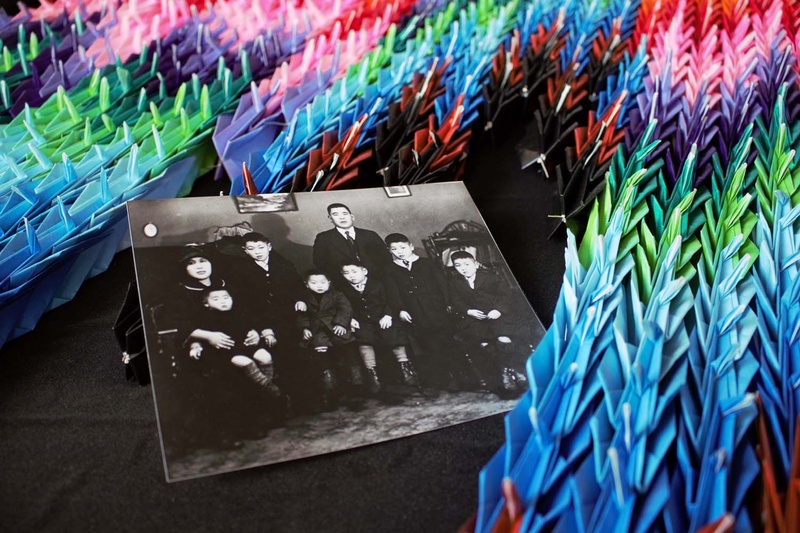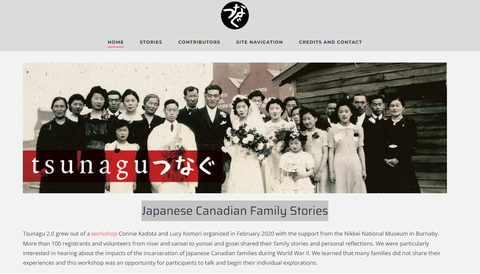I have a curiosity about my father’s family history. Why did my grandfather cross a vast ocean from Wakayama, Japan to an unknown land to seek his fortune? Why don’t we have any relatives in Japan any longer? What are the family traits that I have acquired through osmosis? My father and his brothers were not storytellers, so family lore and values were not explicitly shared with my Sansei cousins and me. Only in recent years have I had the time to interview living Nisei relatives and root around to find answers. I’ve found the exploration rewarding but also incomplete. The stories are perhaps continuously evolving from one generation to the next, hopefully with some basis in events that actually took place.
I wanted to move beyond my immediate family to compare and contrast with other Japanese Canadian (JC) family experiences. There’s no single narrative for sure. My friend Connie Kadota and I organized a couple of group workshops on family history. Just before COVID shut things down, we organized a large group of 100 participants wanting to take a closer look at how JC family stories pass from one generation to the next. We called our workshop Tsunagu, meaning “to connect.” Tsunagu is also used in the context of passing along the family name from one generation to the next.
We started the workshop with panel presentations of parent/child groupings: One Nisei/Sansei and two Sansei/Yonsei pairs. They talked a little bit about their family history and, more importantly, whether they shared this history with their children. (Watch: TSUNAGU 4/5 – Panel Discussion, Part 2) Then the larger group had an opportunity during table discussions to share their family experiences. More often than not, we hear that most Japanese Canadian families did not share their pre-war, wartime, and post-war experiences. Their children were not aware of the hardship, suffering, and racism they endured to provide for their families and move forward.
The live workshop was wonderful for the participants, but we wanted to ensure privacy so we did not feel comfortable sharing the discussions broadly. However, these stories and the impact are important.
How can we push these narratives out to a wider audience?
During COVID, we worked on a website, Tsunagu 2.0. We recruited 30 contributors: 1 Issei, 6 Nisei, 9 Sansei, and 14 Yonsei. 70% of our writers are women. We posed a series of questions which they could answer. They posted 175 entries. The project provided an opportunity and a platform for our writers to think about and share their perspectives for others to read. We identified each of the writers by generation to see how family history moves from one generation to the next.
Issei/Nisei:
We heard about first hand experiences of Japanese Canadians who were incarcerated as young children, teens or young adults along with their families.
Mak Ikuta’s father was a Buddhist minister. His family was sent to Alberta to work on sugar beet farms. The family knew nothing about farming, so they had to rely on their sanga (congregation) members to show them how to plant and harvest the beets. Their incarcerated farm life varied from the harsh work of tending sugar beets to tending their congregation or “flock” day after day.
Howard Shimokura’s father was a physician and became the doctor for those incarcerated in Tashme, the largest incarceration camp in British Columbia. I found it interesting that his family lived separately from the other internees.
“I do not recall having any negative experiences except that for feelings of isolation because of where we lived, and I relished the opportunities to visit other families and meet and play with other children.”
Some of our writers felt their stories were mundane. Kaz Yoshida in particular felt her family story was almost trivial. For me, her words brought the experiences of the incarceration years to life. Her family had an allotted time to cook and eat their dinner. Their mother would rush the family along to ensure she had time to clean up; otherwise she’d have to wait until all the other families completed their meals. Her words give me a sense of the institutional restrictions families experienced. Just like in a prison. They ate at 5 p.m. and even to this day Kaz says she eats at 5 p.m....probably a habit ingrained by her wartime experience.
Jean Okamura’s family had a thriving farm in the Fraser Valley just east of Vancouver. Her parents were older and she had one baby sister. In order to stay together as a family, her parents chose to move to Manitoba to work on a sugar beet farm. Jean comments that there was no community to support her aging parents, and that the camps in BC might have provided more support for them. There was more of a community in which to rely on. At the time, they would not have known that eventually most fathers would be reunited with their families in the government-sponsored camps.
I compare Jean’s family with my father’s. Family circumstances truly dictated the vastly different experiences of JCs in rebuilding their lives after World War II. My father was one of nine children, mostly boys. Their father was also quite old and died in 1945, but the older boys were young adults and were able to sustain their big family by working in logging and sawmilling. They were able to pivot successfully from being fisherman to owning and operating their own sawmill business.
Yosh Arai was a young adult when the family was uprooted. They had a very prosperous dry cleaning business and owned the property in which they lived and ran their business. Yosh was very aware of the injustice taking place. A day before he was to be sent to a road camp, his family moved to a self-supporting community in Grand Forks. They had to sign papers saying they would pay for all their living expenses, including the education of his younger siblings.
Sansei
I don’t know if it’s the group of Sansei we recruited, but most of our writers have a good amount of knowledge of their family history. It’s not first hand experience, so the family lore is told from the perspective of stories passed down. They generally have given their stories a lot of thought and understand the impact of the incarceration of their families, the community and the broader society. Many recognize the trauma that has been passed on to them from their parents and grandparents. We have to work twice as hard. We have to be better. We cannot just be. We have to be great, yet the values of not standing out and being boastful have also been passed along to many Sansei. So we have to be more than “perfect,” but we can’t let anyone know.
Certainly, I see these values and traits in myself. Most of the Sansei and Nisei writers acknowledge the importance of sharing our collective history, so that we as a society do not repeat the heinous actions of the past experienced by our parents and grandparents.
Yonsei
From reading the Yonsei entries, I feel that family stories and our collective history are fading. If the Yonsei writers are fortunate to have a close relationship with their grandparents, they at least have an inkling of the family history. But without that link to the Nisei grandparents, the Sansei parents are key. Whatever the Sansei know, we need to make a concerted effort to share our family knowledge with our children and grandchildren.
From two of our Yonsei writers Sean and Anne Chen:
Our grandma passed when we were 6 and 7, and at the time we didn’t realize what we had or might miss until later in life. Until recently, we never understood how momentary the Japanese-Canadian culture is.
This unique culture, created in such a specific time and space, fades with each generation that passes. If our children are curious about their familial roots, who can they go to in order to learn? Do we have what it takes to give them not only the basic information about their history, but also the deep understanding and respect about who they are and what it means to be Japanese-Canadian?
As children, our grandma was this amazing influence imparting a deep love for our culture in the first few years of our lives. But with the information we know now, we just don’t know how to make our kids feel the same way that we do. Maybe we need to work harder now to understand our culture; learn how to cook the foods we grew up with or visit the cultural centre. This thought gives us hope that this is not the end, and that we can give our kids the gift that has been given to us.
To read more stories from our Issei, Nisei, Sansei, and Yonsei writers, visit Tsunagu 2.0. As many of our writers have commented: When we think about, write down, and share our family experiences, this knowledge will be captured for a time when our children, grandchildren, nieces, nephews, and others are ready and eager to learn about their families’ past...and use that knowledge to understand where they came from and to build their future.
© 2022 Lucy Komori





